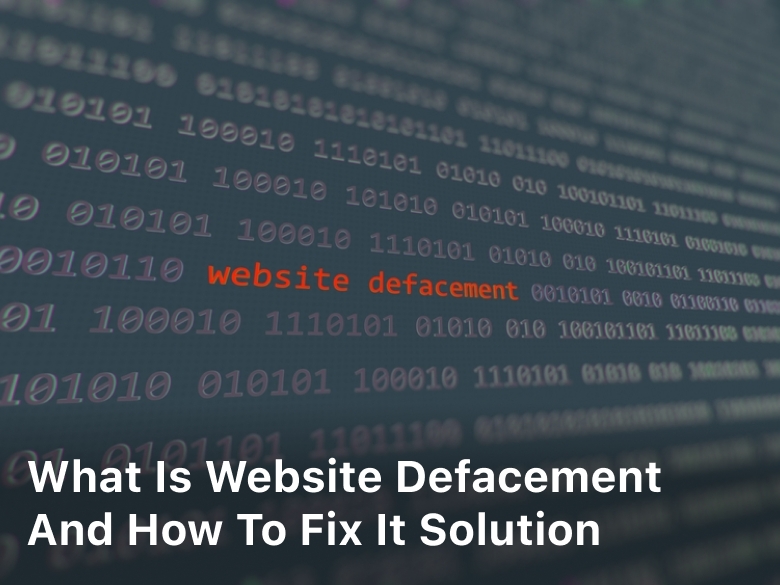What is Website Defacement and How to Fix it Solution
What is Website Defacement and How to Fix it Solution – Explore the world of website defacement, its implications, prevention, and solutions. Learn how to protect your online presence from cyber vandals.
In an era driven by technology, the internet has become an integral part of our daily lives. Businesses, organizations, and individuals rely on websites to connect with their audience and provide valuable information.
However, with the increasing reliance on the digital realm, the threat of cyberattacks has also grown. Among these threats, one of the most malicious and visually striking is “Website Defacement.”
In this comprehensive guide, we will delve into the concept of website defacement, its consequences, prevention strategies, and effective solutions.
What is Website Defacement
Website Defacement is a malicious act in the realm of cybersecurity. It involves the unauthorized alteration of the visual appearance and content of a website by hackers or cyber vandals.
These individuals or groups gain unauthorized access to a website’s server and replace its original content with their own messages, images, or symbols, often for political, ideological, or malicious purposes.
To better understand website defacement, consider the following components:
- Altered Homepage: Hackers typically target a website’s homepage, as it is the most visible part of a site. They replace it with their own content or defacement message.
- Defacement Message: Cyber vandals use this opportunity to convey their message, which can range from political statements to promoting their own agenda or simply taunting the website’s owner.
- Visual Changes: Beyond altering text content, hackers may change images, backgrounds, or even the overall layout of the webpage to make a strong visual impact.
Website defacement can have various motivations, including ideological beliefs, political statements, or a desire for notoriety. It is often used as a means of protest or to draw attention to certain issues.
However, it is essential to note that website defacement is illegal in most jurisdictions, as it involves unauthorized access and damage to digital property.
The consequences of website defacement can be severe, including damage to an organization’s reputation, financial losses due to downtime, and potential legal issues if the defacement involves sensitive or illegal content.
Therefore, website owners and administrators must take proactive steps to prevent and address website defacement, such as implementing robust security measures and regularly monitoring their websites for any signs of unauthorized alterations.

What is an example of website defacement?
An example of website defacement involves an unauthorized individual or group gaining access to a website and altering its content for various purposes. Here’s a fictional example to illustrate the concept:
Scenario:
Imagine a local community organization has a website that promotes events, provides important community information, and connects residents. This website is an essential resource for the community and is trusted by its users.
Website Defacement:
One day, a group of hacktivists with a political agenda gains access to the community organization’s website. They deface the website’s homepage by replacing its original content with their own message and imagery.
- Message: The homepage now displays a message condemning a recent government decision related to environmental policies.
- Images: The defacement includes images of protest signs, environmental slogans, and the group’s logo.
- Slogans: The group adds slogans calling for action and solidarity with their cause.
As a result of this website defacement:
- Damage to Reputation: The community organization’s reputation is tarnished. Users visiting the site are shocked by the altered content and question the website’s security and credibility.
- Loss of Trust: Users who relied on the website for accurate community information lose trust in its reliability. They may no longer view it as a trustworthy source.
- Impact: The community organization faces negative publicity and backlash from users and the local community. Additionally, it may incur expenses to restore the website to its original state and enhance its security.
This example demonstrates how website defacement can be used to convey a message or protest, but it also highlights the potential harm it can cause to an organization’s reputation and trustworthiness. Defaced websites often require swift action to restore normalcy and security.
What causes website defacement?
Website defacement can occur due to a variety of reasons, and the motivations behind these actions can vary widely. Here are some common causes and motivations behind website defacement:
- Hacktivism: Some individuals or groups deface websites as a form of hacktivism, using digital vandalism to raise awareness of political, social, or environmental issues. They may replace a website’s content with messages, images, or slogans that support their cause.
- Political Statements: In some cases, website defacement is used to make political statements or to protest against government policies, actions, or ideologies. Hackers may target government websites or those associated with political figures.
- Vandalism and Notoriety: Some individuals deface websites for the sheer thrill of it or to gain notoriety within the hacking community. These actions are often motivated by a desire for attention or a sense of accomplishment.
- Revenge or Grudges: In certain instances, website defacement may be driven by personal motives, such as revenge or settling scores with the website owner or organization. Hackers might deface websites associated with individuals or entities they have conflicts with.
- Cyber Warfare: Nation-states and state-sponsored hacking groups may deface websites as a part of cyber warfare efforts. These attacks can be aimed at disrupting the digital infrastructure of rival nations or sending political messages.
- Financial Gain: Although less common, some hackers may deface websites as a diversion tactic while carrying out other cybercrimes, such as data theft or ransomware attacks. The defacement can serve to distract security teams from their primary objectives.
- Testing Security: In some cases, hackers may deface websites to test the vulnerability of their systems or to identify security weaknesses. They may then use this information for further cyberattacks.
- Malicious Intent: There are instances where website defacement is carried out for purely malicious reasons, without any clear motive or agenda. These actions may be driven by a desire to cause chaos or simply to display hacking skills.
It’s important to note that website defacement is generally illegal and unethical. It involves unauthorized access to someone else’s digital property and can result in significant harm, including damage to reputations, financial losses, and legal consequences.
To prevent website defacement, website owners and administrators should prioritize cybersecurity measures, such as regular software updates, strong authentication, and robust security protocols.
FAQs
Q1: How can I tell if my website has been defaced?
A1: Check your website regularly for any unusual content or visual changes. Utilize website monitoring tools for alerts.
Q2: Can small websites be targeted for defacement?
A2: Yes, cyber vandals may target websites of all sizes. It’s essential to take security measures regardless of your site’s scale.
Q3: Is it possible to trace the hackers behind website defacement?
A3: Tracing hackers can be challenging, but it’s not impossible. It requires the involvement of cybersecurity experts and law enforcement agencies.
Conclusion
Website defacement is a serious threat in the digital age, with potentially devastating consequences for businesses and individuals alike. By understanding what it is, its consequences, and implementing preventive measures, you can protect your online presence from cyber vandals.
Stay vigilant, keep your website secure, and stay one step ahead of those who seek to deface your digital identity. Remember, prevention is the key to maintaining a safe and reputable online presence.




